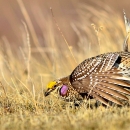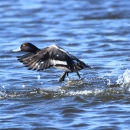Visit Us
National Wildlife Refuge System lands offer us all a chance to unplug from the stresses of daily life and reconnect with our natural surroundings. A designated parking lot, information kiosk, and elevated viewing platform are available along the eastern boundary of the Kellys Slough National Wildlife Refuge. The Refuge is closed to all other public access to provide adequate protection for nesting and migratory birds. Adjacent county and township roads provide excellent opportunities to view wildlife from your vehicle.
Activities
Kellys Slough National Wildlife Refuge is an excellent place to view migratory and breeding waterbirds. More than 35,000 shorebirds visit the Refuge from April to August. More than 12 species of ducks nest here and 22 species of shorebirds have been sighted on the Refuge, making Kellys Slough National Wildlife Refuge a birding destination.
Because it is one of very few wetland areas available to wildlife in the Red River Valley, the Refuge is not open to visitors. You can view and photograph wildlife from our designated parking lot and observation deck. Adjacent county and township roads also offer great opportunities viewing the wildlife of the Refuge.
Other Facilities in the Complex
Kellys Slough National Wildlife Refuge is part of the Eastern North Dakota Complex. A National Wildlife Refuge Complex is an administrative grouping of two or more refuges, wetland management districts or other refuge conservation areas that are primarily managed from a central office location. Refuges are grouped into a complex structure structure
Something temporarily or permanently constructed, built, or placed; and constructed of natural or manufactured parts including, but not limited to, a building, shed, cabin, porch, bridge, walkway, stair steps, sign, landing, platform, dock, rack, fence, telecommunication device, antennae, fish cleaning table, satellite dish/mount, or well head.
Learn more about structure because they occur in a similar ecological region, such as a watershed or specific habitat type, and have a related purpose and management needs. Typically, a project leader or complex manager oversees the general management of all refuges within the complex and refuge managers are responsible for operations at specific refuges or wetland management districts. Support staff may include administrative personnel, law enforcement, refuge manager, biological, and fire staff that are centrally located and support all stations within the complex.
Rules and Policies
To protect wildlife habitat, all foot travel on the Refuge is limited to one area - the established parking area and short trail to a viewing deck. The remainder of the Refuge is closed to public access. The following Refuge regulations also apply:
Off-road motorized vehicle travel is strictly prohibited.
Pets must be under the owner’s control at all times. Pets can disturb nesting birds, and if out of control they can harass or disturb other wildlife.
Searching for and collecting antlers, arrowheads, rocks, and other artifacts is a violation of the Archeological Resources Protection Act and is prohibited.
The Refuge does not provide trash receptacles. You are responsible for disposing of your own trash. Do not leave anything behind. Pack it in, pack it out.
Drones may not be launched, landed, or flown over refuge lands.
Hunting and fishing are not permitted.
Please contact the Refuge Manager with questions regarding Refuge access.








